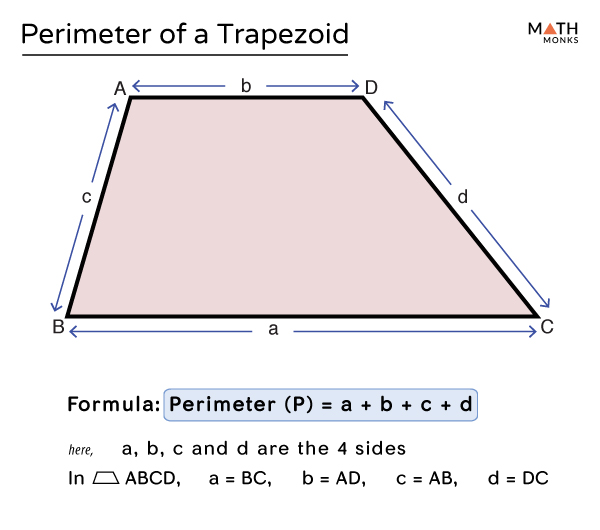How to Find the Perimeter of a Trapezoid
Understanding how to find the perimeter of a trapezoid is a fundamental skill in geometry. A trapezoid, also known as a trapezium in some countries, is a four-sided figure (quadrilateral) with at least one pair of parallel sides. The perimeter of a trapezoid is simply the total distance around the shape, which can be calculated by adding the lengths of all four sides. This article will provide a detailed explanation of trapezoids, the formula for finding their perimeter, various methods of calculation, and practical examples.
Definition of a Trapezoid
A trapezoid is defined as a quadrilateral with at least one pair of parallel sides. The parallel sides are often referred to as the “bases” of the trapezoid, while the other two sides are known as the “legs.” Trapezoids can be classified into different types based on their properties:
- Isosceles Trapezoid: In this type, the non-parallel sides (legs) are of equal length, and the angles adjacent to each base are equal.
- Right Trapezoid: This trapezoid has one angle that is a right angle (90 degrees).
- Scalene Trapezoid: All sides are of different lengths, and there are no equal angles.
Formula for the Perimeter of a Trapezoid
The perimeter P of a trapezoid can be calculated using the formula:
Where:
- a = length of one base
- b = length of the other base
- c = length of one leg
- d = length of the other leg
This formula states that the perimeter is the sum of the lengths of all four sides.
Steps to Calculate the Perimeter of a Trapezoid
To find the perimeter of a trapezoid, follow these steps:
- Measure the Lengths of All Sides: Use a ruler or measuring tape to find the lengths of both bases and both legs.
- Apply the Perimeter Formula: Substitute the measured lengths into the perimeter formula.
- Perform the Calculation: Add the lengths together to find the total perimeter.
Example Calculations
Example 1: Basic Trapezoid
Problem: Find the perimeter of a trapezoid with the following dimensions:
- Base 1 (a) = 10 cm
- Base 2 (b) = 15 cm
- Leg 1 (c) = 7 cm
- Leg 2 (d) = 5 cm
Solution:
Example 2: Isosceles Trapezoid
Problem: Find the perimeter of an isosceles trapezoid with:
- Base 1 (a) = 12 cm
- Base 2 (b) = 20 cm
- Legs (c and d) = 9 cm each
Solution:
Example 3: Right Trapezoid
Problem: Calculate the perimeter of a right trapezoid where:
- Base 1 (a) = 8 m
- Base 2 (b) = 12 m
- One leg (c) = 5 m
- The other leg (d) is unknown but can be calculated using the Pythagorean theorem.
Assuming the trapezoid has a height of 5 m, the length of the other leg can be calculated as follows:
- The difference between the bases is 12−8=4 m.
- Use the Pythagorean theorem:
d=(4)2+(5)2=16+25=41≈6.4 m
Now, calculate the perimeter:
Special Cases
Finding the Perimeter with Missing Sides
In some cases, you may not have all the side lengths but can derive them using the properties of trapezoids and the Pythagorean theorem. For instance, if you know the lengths of the bases and the height, you can find the lengths of the legs if the trapezoid is a right trapezoid.
Practical Applications of Trapezoids
Trapezoids are commonly found in various fields, including architecture, engineering, and design. They can represent shapes in structures, furniture, and even art. Understanding how to calculate the perimeter of a trapezoid is essential for tasks such as:
- Construction: Calculating the amount of material needed for framing or roofing.
- Landscaping: Determining the perimeter of garden beds or patios.
- Graphic Design: Creating layouts that incorporate trapezoidal shapes.
Frequently Asked Questions (FAQ)
What is the formula for the perimeter of a trapezoid?
The perimeter of a trapezoid is calculated using the formula:
Where a and b are the lengths of the bases, and c and d are the lengths of the legs.
How do I find the perimeter if I only know the bases?
If you only know the lengths of the bases, you cannot determine the perimeter unless you also know the lengths of the legs. If the trapezoid is isosceles, you can use the length of one leg to find the perimeter.
Can the perimeter of a trapezoid be calculated without all side lengths?
Yes, if you know the height and the lengths of the bases, you can use the Pythagorean theorem to find the lengths of the legs in right trapezoids.
What is the difference between a trapezoid and a parallelogram?
A trapezoid has at least one pair of parallel sides, while a parallelogram has two pairs of parallel sides. This means that all angles in a parallelogram are equal, while a trapezoid can have angles of different measures.
How do I find the perimeter of an isosceles trapezoid?
For an isosceles trapezoid, the perimeter can be calculated using the formula:
Where a and b are the lengths of the bases, and c is the length of the legs.
Conclusion
Finding the perimeter of a trapezoid is a straightforward process that involves measuring the lengths of the sides and applying a simple formula. With practice, you can easily calculate the perimeter of various types of trapezoids, whether they are isosceles, right, or scalene. This knowledge is not only useful in academic settings but also in practical applications across different fields.
| Characteristic | Link |
|---|---|
| Trapezoid | https://en.wikipedia.org/wiki/Trapezoid |
Read more about it:https://greyhoundsverdevalley.com/wp-admin/post.php?post=5768&action=edit



